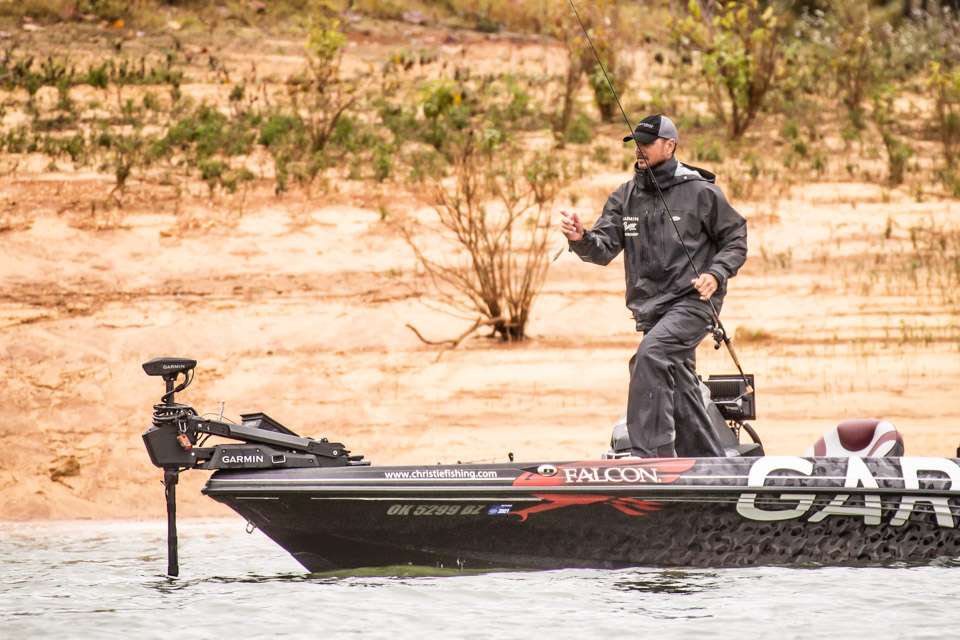
If you’re one of those anglers who assumes you have to revert to finesse tactics when the water gets cold, Jason Christie has some advice for you.
Try fishing deep jerkbaits.
“You can catch them on finesse tactics when the water gets cold, but I’ve found I can catch a lot of big fish on jerkbaits and cover water quicker,” he said.
Christie reaches for the Smithwick Rogue Perfect 10 when the water temp gets below 50 degrees. The 5 1/2-inch bait with a larger-than-normal bill and titanium ball insert dives to 10 feet on an average cast and farther on a long cast.
Don’t be concerned about the larger size of the bait. It often matches the size of shad the bass are targeting.
“During the winter, there are a lot of shad dying off, and I’ve caught several fish with giant gizzard shad sticking out of their throats,” he said. “The bass don’t eat as often then, but they will take bigger meals when the opportunity is there.”
The deeper running jerkbait is a must during cold water periods.
“When the water gets clear in the winter months, the fish lounge a little deeper, especially on sunny days,” Christie explained. “Whereas they might typically be on 8-12 foot ledges, they will live in 18-20 feet under bright skies.”
Although the Perfect 10 only gets to 10 feet or so, Christie has caught fish coming up from 25 feet to get it.
“I also think a lot of bass are feeding up that time of year,” he added. “So a jerkbait not only puts the bait where they are focused and accustomed to feeding on bait overhead, but it allows me to keep a bait deeper and in the strike zone longer.”
Also, the bass tend to hang tight to cover, be it rocks or brush piles. Jigs and other slow moving baits tend to hang-up in the brush, whereas the jerkbait can be worked freely over the top of the cover.
He says he can fish through areas faster with a jerkbait, too, even though he’s fishing it at a little slower pace.
“Sometimes during the winter months, you have to fish through areas you suspect the fish are using, and I can make a lot more casts than if I’m fishing slower moving baits,” said Christie.
That doesn’t mean he’s using the same rapid retrieve he fishes during warmer months. He prefers a jerk, jerk, jerk pause, and then maybe a single jerk before another pause.
“When I think the fish are lethargic or the water is really clear, I may let the bait sit for four or five seconds before jerking again,” he said. “That also works well when you see fish tracking the bait and they won’t hit it. Under those conditions, long pauses can get them to bite better.”
Christie keeps his colors simple, preferring the translucent jerkbaits in real clear water and painted versions in stained water. He rigs up the Perfect 10 on a 6-6 Falcon 5 power (medium action) rod, noting that the shorter rod works best for him.
Longer rods work, too, but Christie says the shorter version gives him an advantage.
“In cold weather, I have a lot of clothes on, so I get more fatigued with a longer rod when working a jerkbait all day,” he said. “And the 6-6 rod plays the fish well in that cold water.”
He also uses Lew’s Magnesium baitcast reel with a 6:1 gear ratio. Faster geared reels pick up too much slack when he wants to work it slower, he noted.
When the deep jerkbait is on, he will rig two rods identically, but one with 10-pound Sunline Sniper Fluorocarbon and another 16.
“There is a three-foot depth diving difference between the two line sizes,” he explained. “When the cover is shallower I’ll fish the heavier line, but if I need to go deeper, I will pick up the 10-pound-line rig.”
Originally published in 2018.





